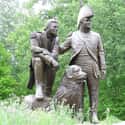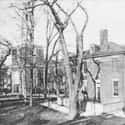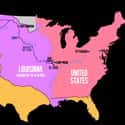-
(#5) Tribal Teenagers Stole Meriwether Lewis's Dog
Meriwether Lewis purchased a Newfoundland puppy while preparing for the journey. For more than a century, scholars were confused about the dog's name, which appears only once in Lewis's journal (typically, he referred to it as "my dog"), but this one iteration was written near the bottom of the page, and got smudged. At some point historians decided the dog's name was Scannon, but were clueless to the meaning.
Actually, Lewis's beloved pet was named Seaman, which is appropriate for a member of a breed known for a love of swimming and often trained to rescue those in distress. On many occasions, Seaman saved Corp members from drowning. Once, though, Lewis saved Seaman. Lewis reported in his journal that a beaver attacked Seaman, severing an artery in his leg. He wrote in his journal, “It was with great difficulty that I could stop the blood; I fear it will yet prove fatal to him.” The dog recovered.
Seaman was very popular with the Corp. He was petted and spoiled with treats. He was also very protective, barking and warning those he suspected might harm the Corp. When the men at long last encountered their first grizzly bear, Seaman had to be held back from attacking the enormous creature. He once chased a bull buffalo away from a tent where Corp members were sleeping. He was close to Sacajawea and her baby, John Baptiste, and allowed the little boy to crawl on and around him.
One thing Seaman did not care for was the massive clouds of mosquitoes that plagued the Corp on certain parts of their expedition. He would always seek a pond, creek, or river from which to escape the infernal bites from the pests.
A number of the tribal people the Corp encountered on their western trek were impressed with the enormous, shaggy-coated dog. One man from a tribe along the Columbia River unsuccessfully offered Lewis three beaver pelts for Seaman. On another occasion, some local tribal youth stole the dog during cover of darkness. Lewis was incensed when he discovered Seaman missing, tracked down the guilty parties and threatened to burn their village to the ground if they did not return his dog immediately.
Not much is known about Seaman after the expedition. However, in a book published in 1814, a well-known educator claims to have visited a museum with a large dog's collar bearing the inscription: "The greatest traveller of my species. My name is SEAMAN, the dog of captain Meriwether Lewis, whom I accompanied to the Pacifick ocean through the interior of the continent of North America."
Apparently Seaman never learned to spell.
-
(#11) Little Evidence Remains Along The Trail Today
The only physical mark left on the landscape by the Corp during its journey is an inscription on Pompeys Pillar, a massive rock formation in Montana, by William Clark. The formation is named after Sacajawea's infant, Jean Baptiste, whom the Corp nicknamed Pompey, after the Roman general.
The men had a habit of carving their names in trees along the trail, the most famous instance of which came when they had reached the Pacific Ocean. Each member of the Corp joyously carved his name in a grove of trees. The area remained wilderness for many years but no longer exists. No one knows how long the group of trees stood before felled by those who likely had no clue.
At least one boat used by the Corp was abandoned along the way, but has never surfaced. Archeologist Ken Karsmizki has researched potential Corp campsites for years, and claims the group created more than 600 camps during its journey. He has found some physical evidence of camps, such as musket balls, rifle flints, campfire residue, and other small items.
Thomas Jefferson sent 90 metal medallions on the mission. They featured Jefferson's visage, and were presented by Lewis and Clark to tribal chiefs along the trail. The chiefs were told the gifts portrayed their new "Great Father" in the east, and were warned to cooperate with the Corp and Jefferson. The chiefs were apparently not terribly impressed, though at least seven medallions survive and are held in museum collections.
-
(#3) Despite A Treacherous Journey, Only One Member Was Lost
When you consider the unimaginable risks and dangers undertaken by the Corp of Discovery, that it suffered only one casualty is remarkable. But such was the case.
Only three months into the journey, young Sergeant Charles Floyd became ill with nausea and severe abdominal pains. Lewis and Clark were particularly fond of the young man, as he was the first to apply for the job, was rigorously fit, and better educated than most of his fellow Corpsmen. The two leaders even agreed to grant Floyd the rank of sergeant before the journey began. So everyone was surprised someone of so many fine qualities and great health would be the first to falter.
The members of the Corp knew they were heading into harm's way when they joined up, but they figured their lives were mostly at risk from wild animal attack or skirmishes with angry tribal people.
Alas, there was no help for Sergeant Floyd. His suffering only worsened. William Clark sat up all night long watching over and trying to help the young man. Lewis recorded in this journal that, on August 15, after seeming to recover a bit, Floyd was “seized with a complaint somewhat like a violent chorlick [colic]… [and] he was sick all night.” On the afternoon of August 19, Floyd passed away, according to Lewis, "with composure."
Ironically, even if Floyd had somehow been magically transported to the finest doctors in Philadelphia, none of them could have saved him. He likely died from a burst appendix, and in the early 19th century, that was a death sentence, no matter one's location.
Members of the expedition buried Floyd on a high bluff overlooking the Missouri River, placing a red cedar marker at his grave site that stated his name, title, and life dates. The men were so moved by their unexpected loss they recorded Floyd River and Floyd Bluff on a new map drawn by Lewis.
Over the next more than two years the Corps of Discovery lost no other members to death.
-
(#15) A Wagon Load Of Strange Goods Was Sent Back To Jefferson
The Corp gathered samples of flora and fauna throughout the journey, at the request of Jefferson, who was a curious and methodical man interested in examining whatever specimens the Corp discovered. Along the way, Lewis carefully recorded as many details as possible for each new item, and drew intricate sketches.
On April 2, 1805, the Corp was in Fort Mandan, ND. On that day, Lewis recorded in his journal: "we are all day engaged packing up Sundry articles to be sent to the President of the US." A wagon, driven and accompanied by two men from the Corp, was sent to Washington, DC. It was the only en route shipment made during the entire expedition.
Loaded onto the wagon were:
"four boxes, one trunk, and three cages. The cages contained a live prairie dog, a sharp-tailed grouse, and four magpies. The boxes and trunk held pelts, horns, and skeletons of various animals; dried plant, soil, mineral, and insect specimens; Mandan and Hidatsa artifacts and items, and Arikara tobacco and tobacco seed. Labels included the date and place each item was obtained and a brief description."
Jefferson received the shipment August 1805. He kept some of the items, most of which can be viewed at Monticello. The remainder were sent to the American Philosophical Society in Philadelphia, and to individual scholars and scientists.
-
(#2) Once The Expedition Left US Jurisdiction, It Became Fully Egalitarian
Once the expedition moved out of official US territory, their laws were of their own choosing. Every member of the Corp had a vote, no matter the decision or activity.
York, the only married man, and only African-American in the Corp, was William Clark's slave. At least, back home he was. But beyond US jurisdiction, he was a free man and became a major and highly valued member of the Corp.
Sacajawea was a pregnant, teenage Shoshone woman. In the States, those three qualities would have gotten her nowhere. But out on the trail, she was the expert, saving lives and property on a number of occasions. Her knowledge and grace earned her full respect among the Corp. She, too, was a leader, held her own vote, and made her own decisions. None of these things would have been possible in the US.
Even the enlisted members of the Corp, all young, white men, had opportunities beyond comprehension as they moved and learned along the trail. They were all country boys, few from great means, but their journey broadened and enlightened their minds in ways they never would have achieved had they stayed back home.
As a unit, the Corp worked together in kindness and respect for one another, no matter one's origins, status, or ethnicity. The journey was not without flaws, but those facts alone make the expedition an exceptional standout in all of American history.
-

(#16) Lewis Filled Journals With Beautifully Detailed Art
Lewis was a gifted artist and the meticulous keeper of the expedition's journal. Thanks to preservationists, historians, Sacajawea (who famously rescued the journals from a raging river), and Lewis, the journals still exist.
Lewis's sketches of the flowers, plants, and animals discovered by the Corp must be viewed to be truly appreciated. The detail is stunning, both in sketch and description. Lewis's journal entries are precise and neat, with no indication that he wrote and sketched while exhausted, or swatting a cloud of mosquitoes intent on making him their dinner, or even while he rode a wagon or piloted a boat. He never lost his edge; he never lost his cool. It is as though he knew instinctively the vast importance of his record.
Lewis's journals are bound in leather and kept at the American Philosophical Society in Philadelphia, where you can request an appointment to view the rare treasures.
New Random Displays Display All By Ranking
About This Tool
The Lewis and Clark expedition is the first round-trip expedition of the United States across the continent west to the Pacific coast. The team is led by Meriwether Lewis and William Clark of the United States Army. The event was initiated by President Jefferson. They led the expedition with a total of 45 people, including translators who understood Spanish and Indian and allowed the expedition to use military means if necessary.
The expedition spent nearly 2 years to explored the Missouri River and its main tributaries, as well as the plains and Indian tribes along the Pacific coast. The random tool introduced 17 facts about The Lewis and Clark expedition that you must be interested in.
Our data comes from Ranker, If you want to participate in the ranking of items displayed on this page, please click here.















